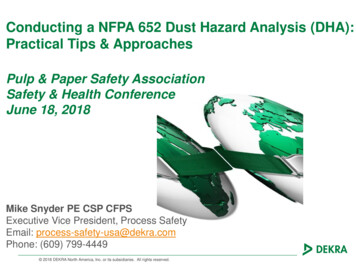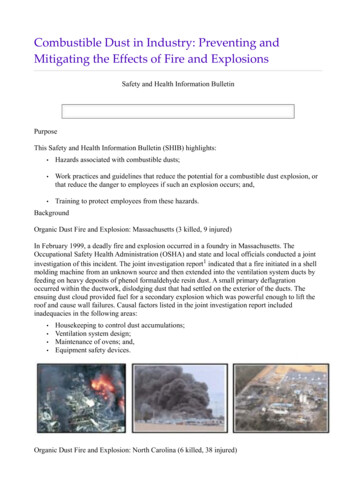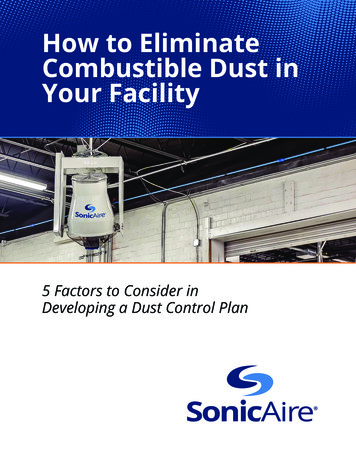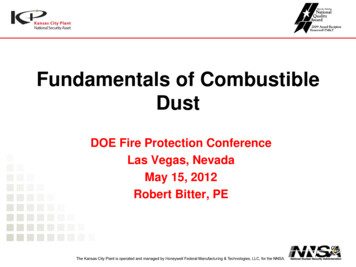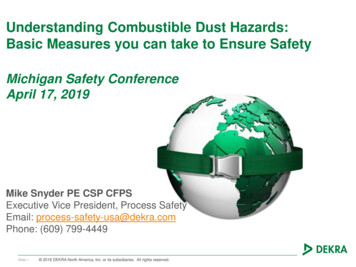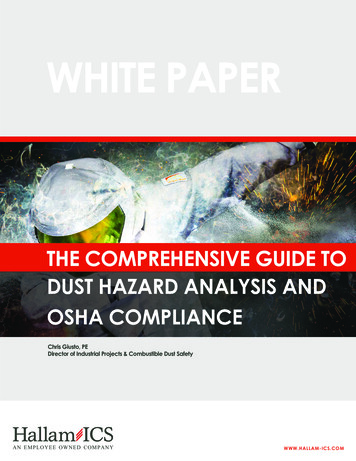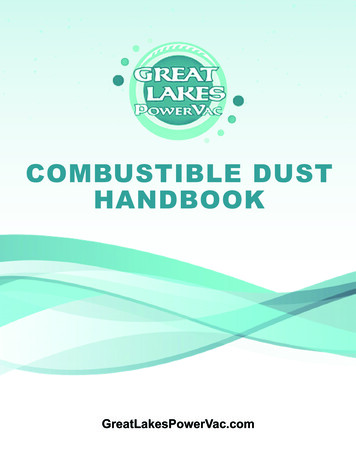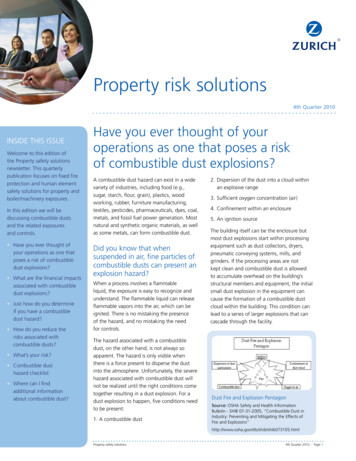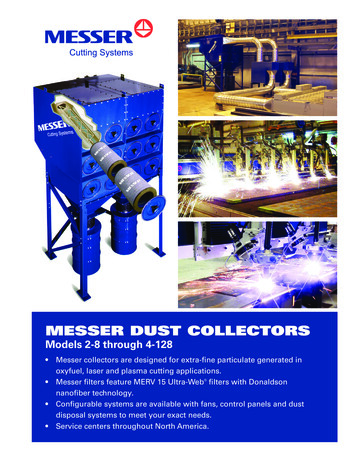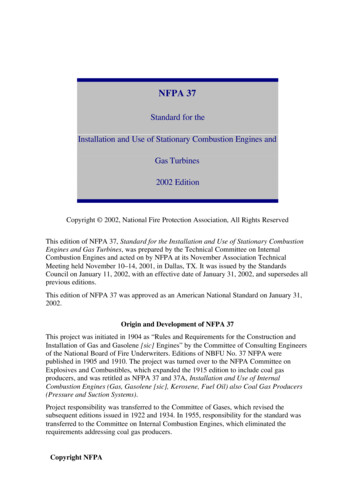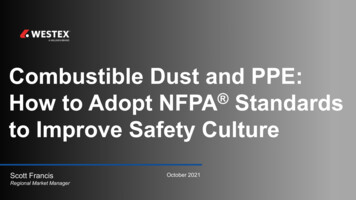
Transcription
Combustible Dust and PPE: How to Adopt NFPA Standardsto Improve Safety CultureScott FrancisRegional Market ManagerOctober 2021
Agenda 2Combustible Dust BasicsOSHA – Combustible Dust Regulations and FinesNFPA 652 Standard – Compliance RequirementsManaging Identified Fire, Flash Fire and Explosion HazardsNFPA 70E Risk Assessment Procedure – Human ErrorNFPA 70E – Annex Q – Human Performance and ImprovedSafety CulturePPE Program Types and Best PracticesCombustible Dust Incident Causes and Injury DataBurn Injury and CostComfort and Heat StressSummaryQuestions
Combustible DustImperial Sugar (GA)3
Combustible Dust EventDUSTEXPLOSIONPENTAGON4 Combustible dusts are fine particles thatcan present explosion, deflagration andflash fire hazards. Combustible dusts dispersed in sufficientquantities, along with oxygen and heat, canlead to rapid combustion known asdeflagration. This pressurized fire can leadto combustible dust explosions. Five key conditions: Combustible dust is thefuel, but an explosion manifests with fourother factors—oxygen, heat, dispersion andconfinement. Explosions can furtherdisperse combustible dust, creating andpropagating multiple secondarydeflagrations and flash fires.
Combustible DustViolation and FinesDidion Milling5 On May 31, 2017, a grain dust explosion ripped through the Didion Millingfacility in Cambria, Wisconsin. The tragic incident resulted in 5 fatalitiesand 13 injuries. Total Serious 63,375 Serious (Equipment) 38,025 Serious (Training& Maintenance) 25,350 Total Willful 1,774,468 Willful (Equipment) 253,498 Willful(Housekeeping) 760,494 Willful (Safety Systems) 253,498 Willful(Personal Protective Equipment) 126,749 Willful (Maintenance) 380,247 Total Proposed Penalties: Over 1.8 Million
OSHA ViolationsFines for Didion Milling Combustible Dust Incident A willful violation—most severe, requires that the employer either knowinglyfailed to comply with legal requirements or acted with plain indifference toemployee safety. In the willful violation at Didion Milling, OSHA proposed flame-resistantclothing was not provided to protect from potential flash fires in the milling,packaging and bulk load out areas of the facility. Violation: 29 CFR 1910.132(a) Description: Failure to provide flame-resistant clothing Protection Methods: See NFPA 2113 for guidance on use of flameresistant garments Proposed Penalty: 126,749.006
Combustible Dust Incident Reports7 DustSafetyScience.com The agricultural and food processing industry saw an increase in thepercentage of total combustible dust incidents from 32% to 44% in thepast few years. Agricultural/food processing facilities have until 1/1/2022 to perform a DustHazard Analysis (DHA) per NFPA .
OSHA and NFPA StandardsOSHA CFR 1910.132, 1910.1200, 1910.22 (Hazard Assessment and PPE Selection) Dust collector maintenance, abatement tasks, cleaning and (blow down) tasks allmay require flame-resistant clothing/PPE in dust environments.NEP (National Emphasis Program): re-adopted Enforcement is still in place. OSHA is actively inspecting and fining companies.NFPA 652 Provides a set of general requirements forthe mitigation of fire and explosion hazardsassociated with combustible dusts. Chapter 8 mentions FRC with references toNFPA 2113 for hazard assessment and2112 for FRC certification.8
NFPA 652Owner/Operator ResponsibilityChapter 5 Determine Combustibility and Explosibility Hazards of Materials(guidance from DHA consultant or testing lab on appropriate dust tests)Chapter 7 Conduct a Dust Hazard Analysis (DHA)Chapters 4, 9 Manage Identified Fire, Flash Fire and Explosion HazardsChapter 8 Establish Written Safety Management System (PPE references)9
Dust Hazard Analysis (DHA)NFPA 652 Dust Hazard Analysis (DHA) is a systematic evaluation of potentialcombustible dust fire, flash fire or explosion hazards in a process or facilityand the recommendation of measures for their management. ID, evaluate,recommend and document–priorities are set by risk assessment. NFPA 652(2019)–Dust Hazard Analysis (DHA) is required by 9/7/2020 forexisting processes and facilities. New construction: DHA is part of the project. For Agricultural and Food facilities, the DHA has been extended to 1/1/2022. DHA is reviewed and updated every 5 years. It must be conducted bysomeone with proven expertise. Example of DHA in Annex B of NFPA 652.10
Managing Identified Fire andExplosion HazardsNFPA 652To meet life safety, mission continuity and mitigation of fire spreadand explosions, there are two options to manage the hazards:A prescriptive approach in accordance with Chapters 5, 7, 8 and 9 ofNFPA 652 (2019) in conjunction with any prescriptive provisions ofapplicable commodity/industry, such as NFPA 61 for Agriculture and Foodprocessing facilities.A documented, performance-based approach in lieu of the prescriptiverequirements in accordance with Chapter 6 of NFPA 652 (2019).11
Managing Identified Fire andExplosion HazardsPreventive and protective measures via key risk control methodsEngineering controls Explosion protection via venting, suppression, containment and isolation.Explosion prevention via reducing oxidant concentration.Administration controls Controlling/eliminating fuel (dust) and ignition sources. Thoroughhousekeeping/maintenance procedures to control dust accumulation,maintenance of dust collectors and elimination of potential ignition sourceswith proper procedures and permits.PPE Employees are protected from combustible-dust-related deflagrations andflash fires through appropriate flame-resistant PPE.12
NFPA652 (2019)Chapter 8 – Management SystemsNew – PPE and Workplace Hazard Assessment N 8.4.3 Training: Employee and contractor training shall includehousekeeping procedures, required PPE during housekeeping and properuse of equipment. N 8.6.1.1* An assessment of workplace hazards shall be conducted as described in NFPA 2113. N 8.6.1.2 When the assessment in 8.6.1.1 has determined thatflame-resistant garments are needed, personnel shall be providedwith and wear flame-resistant garments. N 8.6.1.3* When flame-resistant clothing is required for protectingpersonnel from flash fires, it shall comply with the requirementsof NFPA 2112.13
NFPA652 (2019)PPE – Chapter 8 – Management SystemsN 8.6.1.4* Consideration shall be given to the following:1. Thermal protective characteristics of the fabric over a range of thermalexposures2. Physical characteristics of the fabric3. Garment construction and components4. Avoidance of static charge buildup5. Design of garment6. Conditions under which garment will be worn7. Garment fit8. Garment durability/wear life9. Recommended laundering procedures10. Conditions/features affecting wearer comfort14
NFPA652 (2019)PPE – Chapter 8 – Management SystemsNFPA 652 (2019) – Chapter 8 N 8.6.1.5 Flame-resistant garments shall be selected, procured, inspected,worn and maintained in accordance with NFPA 2113. N 8.6.1.6* The employer shall implement a policy regarding care, cleaningand maintenance for flame-resistant garments. N 8.6.2.1* When required by 8.6.1.2, flame-resistant or non-meltingundergarments shall be used. N 8.6.2.2* When determined by 8.6.1.1 that flame-resistant garments areneeded, only flame-resistant outerwear shall be worn over flame-resistantdaily wear.Also, Annex A 8.4.2 Model Programs references PPE, including FRC inaccordance with the hazard analysis outlined in NFPA 2113.15
Flame-Resistant ClothingPPE for Combustible Dust: SummaryMany changes to NFPA 652 2019 edition require using flame-resistantclothing as PPE as warranted by the hazard analysis.A combustible dust OSHA final rule is very unlikely, however, OSHA is citingcurrent regulations, like CFR 1910.1200 Hazard Communication and CFR1910.132. They are inspecting facilities via OSHA NEP (National EmphasisProgram).In the latest changes to NFPA 652, dates were listed regarding FRC and DHAdeadlines. Most dates are past due or rapidly approaching; it’s time to finishthe DHA and implement appropriate risk controls!16
Changes to NFPA 70E The 2021 edition released in Fall 2020includes several significant changes relatedto the risk assessment procedure and FR/ARclothing that impact PPE Best Practices.17
NFPA 70E 110.1(H)Risk Assessment Procedure(2) Human Error“The risk assessment procedure shall address the potential for human error andits negative consequences on people, processes, the work environment andequipment.” “Informational Note: the potential for human error varies with factorssuch as tasks and the work environment. See Informative Annex Q.”18
NFPA 70E110.1 (H)Risk Assessment Procedure(3) Hierarchy of Risk Control MethodsThe risk assessment procedure shall require that preventive and protective riskcontrol methods be implemented in accordance with the following hierarchy:(1) Elimination(2) Substitution(3) Engineering controls(4) Awareness(5) Administrative controls(6) PPENo control is infallible. All of the risk controls are subject to errors in humanperformance.19
Info. Annex QHuman Performance and Electrical Safety Human Performance: Aspect of risk management that addresses humanperformance as a factor that either leads to or prevents errors. High Risk Industries-Human Error-Root Cause Human performance addresses human error as a unique control that iscomplementary to the hierarchy of risk controls.20
Info. Annex QPrinciples of Human Performance1) People are fallible; even the best people make mistakes.2) Error-likely situations/conditions are predictable, manageable andpreventable.3) Individual performance is influenced by organizational processes andvalues.4) People achieve high levels of performance with encouragement fromleaders and peers.5) Incidents can be avoided by understanding why mistakes occur and howlessons can be learned.21
Info. Annex QHuman Performance and Electrical SafetyError PrecursorsError Precursors are situations when the demands of the task environmentexceed the capabilities of the worker or the limitations of human nature.Also, precursors can be unfavorable conditions that increase the probability forerror during a specific work task.22
NFPA 70E Informative Annex QTable Q.5Error PrecursorsTask Demands Time Pressure (In aHurry) Lack of ClarityWork Environment Distractions /Interruptions UnexpectedConditionsIndividualCapabilitiesHuman Nature23Optimal Tool(s)Human PerformanceTool(s) Pre-Job Briefing Self Check withVerbalization(STAR) Lack of Knowledge(Faulty Mental Model) Lack of Experience Stop When Unsure Complacency /Overconfidence Stress Job Site Review
Human PerformanceWarning Signs Engaging in consensus or group thinking, without different viewpoints Personnel overly defer to managers and perceived experts Activities with high risk are not assigned clear owners The organization assumes risk management is healthy because a programor process was establishedPast success without adverse outcomes becomes the basis for continuingcurrent practices.24
Info. Annex QHuman Performance and Electrical SafetyWorkplace Culture Promote open communication Foster a culture that values error prevention and the use of humanperformance tools Identify and prevent the formation of error-likely conditions Support continuous improvement and learning across organization Establish a blame-free culture that supports incident reporting andproactively identifies and appropriately reacts to risk25
PPE Culture: Top ReasonsEmployees Fail to Wear PPEFORGETFULNESS“I just forgot.”MISUNDERSTANDING“I didn’t know.”FEARLESSNESS, OVERCONFIDENCEand COMPLACENCY“I won’t get in an accident.”“I’ve gone my career without an accident.”“That only happens to other people.”26TIME CONSTRAINTS“I didn’t have time.”“It takes too much time.”DISCOMFORT“It doesn’t fit right.”“It’s not comfortable.”“It’s too hot!”
Types of FR/AR Clothingand PPE Programs27TASK BASEDDAILY WEARProper FR/ARclothing is puton to perform aspecific task.Proper FR/ARclothing is wornat all times duringwork hours.
Cultural RiskTask-Based PPE SystemsA significant amount of incidents occur involving either brand-newemployees or more-experienced employees.28
Cultural Risk with Task-BasedPPE Programs Routine Tasks: Will workers consistently don PPE at the appropriate time?Or be complacent? Normalization of Deviance: The gradual process through whichunacceptable practices and standards become acceptable. As the deviantbehavior is repeated without catastrophic results, it becomes the socialnorm of the organization. Human error is usually the root cause of incidents. Over 90% of incidentsare linked to errors in human performance, while less than 10% are fromhazardous conditions. FR/AR clothing is a SEAT BELT!29
RisksAssociated with Both Types of Clothing/PPE ProgramsLIABILITYCONCERN30Improper wearXNon-FR clothingovertop FR/AR clothingXPRODUCTIVITYINHIBITOR
LIABILITYCONCERN31PRODUCTIVITYINHIBITORWill the employee recognize the hazard? Are they actingwith complacency?XDo they have the clothing they are supposed to havewith them? Will they put it on? Is it put on over naturalfiber clothing? Comfort equals protection.XXIf the clothing is out in the truck or in their locker,will they take the time necessary to retrieve it?Is it inconvenient?XXDo other people who are assisting with electricalmaintenance on the border of arc-flash boundaryhave the proper FR/AR clothing on?XIs the employee in a hurry because it is lunch time, theend of the day, or they are on a tight job schedule? If so,will they take extra time to put on their FR/AR clothing?XX
Level of Risk Recap There’s risk associated with both types of FR/AR clothing programs. Task-based clothing has a significantly larger amount of associated riskbecause of human error. Task-based FR clothing programs increase the chance of exposingflammable clothing to thermal hazards that can result in significant burninjury or even death.32
Is Compliance Enough?Insulation33*All figures include 7% for the head
Flash Fire and PPE Flash fires can happen subsequently in combustible dust events. Flash fireshave a rapidly moving flame front, similar to deflagration, but without thepressure component of deflagration and explosion. Dispersed from initial explosion, combustible dust is the fuel. A subsequentflash fire can propagate and cause serious burn injuries. Preventative risk controls reduce likelihood of incident occurrence, but if anevent occurs, the last risk control, PPE, will mitigate severity of burn injury.34
Burn Injuries and DeathsKnown Cases Between 1980 and 2005, the U.S. Chemical Safety Board identified 281combustible dust incidents that caused 119 fatalities and 718 injuries. Injuries, primarily resulting from burns, occurred at roughly a 7:1 ratio overfatalities during that time frame. FR PPE, if it was worn at the time, would likely have reduced not onlyfatalities from catastrophic burn injury, but also reduced burn injuries overall.35
ST Classes and ExplosivenessDust Hazard Analysis (KST Value)KST value is obtained in the lab as the normalized rate of pressure rise ofcombustible dust. This value helps estimate the severity of dust deflagration orexplosion.ST class 0ST class 1ST class 2ST class 336KST 0,KST 200 bar m/sec,KST 200 - 300 bar m/sec,KST 300 bar m/sec,No explosionWeak explosionStrong explosionVery strong explosion
Combustible DustCase StudiesKST134(ST1)37FacilityRubber garRefineryStateNCKYGADustPolyethylenePhenolic ResinSugarKilled6714InjuredReasons38No hazardassessment, Nohazardcommunication, Poorengineering37No hazardassessment, Nohazardcommunication, Poorbuilding design36Poor equipmentdesign, Inadequatehousekeeping
Combustible DustImperial Sugar (GA)38
Burn InjuriesThree Factors: Extent, Severity and -between-3rd-and-4th-degree-burns/
Survival Factors Odds of survival fall with total % burn Odds of survival fall precipitously above 50% burn Odds of survival fall as age increases40
Burn Injury CostsAge% of 2nd &3rd degreeburns40-49 year old50%Risk ofdeathAvg. hospitalstay forsurvivorAlmost40%3 days per %of body burnAvg. costper dayTotal avg.cost 7,791 1,168,650 The risk increases with smoke inhalation. This does not include rehabilitation or reconstruction, which can benecessary years after injury. For people over 50, the risk of morbidity (illness) and mortality (death) fromtheir injury increases.41
PPE Culture: Top ReasonsEmployees Fail to Wear PPEFORGETFULNESS“I just forgot.”MISUNDERSTANDING“I didn’t know.”FEARLESSNESS, OVERCONFIDENCE,and COMPLACENCY“I won’t get in an accident.”“I’ve gone my career without an accident.”“That only happens to other people.”42TIME CONSTRAINTS“I didn’t have time.”“It takes too much time.”DISCOMFORT“It doesn’t fit right.”“It’s not comfortable.”“It’s too hot!”
Innovative FR/AR fabrics Daily wear is single-layerclothing. Task based is double-layerclothing (layering FR/ARcoverall over non-FR,natural-fiber clothing). The technical advancements in FR/AR fabrics have made them almostindistinguishable from street clothing.43
Summary Recognize human error potential in the risk assessment and utilize humanperformance modes—tools to improve safety culture. See Annex Q ofNFPA 70E . Adopt daily-wear programs to provide better protective measures; they’remore likely to reduce burn injury consequences of human error exposingnon-FR clothing (FUEL) to a thermal hazard. Understand the two protective roles of FR/AR PPE: 1) self extinguish 2)insulate Remember daily-wear clothing can also serve as a preventative measure.It’s all about proper safety mind set! Recall the cost of treatment, length of recovery and chances of mortalityincrease significantly with the increase in % body burn (extent).44
SummaryNFPA consensus standards focus on how to reduce the likelihood ofincident occurrence and mitigate the severity of burn injury from arc-flashand flash-fire hazards—shedding new light on PPE program best practices.The daily-wear programs—with innovations in fabric and garmenttechnology—now provide a comfortable, “want to wear”, “best practice”program that further reduces the burn injury risk and increases anorganization’s safety culture.45
Questions?vScott FrancisRegional Market Manager, Westex: A Milliken Brandscott.francis@milliken.com 2018 Westex by Milliken
PPE for Combustible Dust: Summary Many changes to NFPA 652 2019 edition require using flame-resistant clothing as PPE as warranted by the hazard analysis. A combustible dust OSHA final rule is very unlikely, however, OSHA is citing current regulations, like CFR 1910.1200 Hazard Communication and CFR 1910.132.
